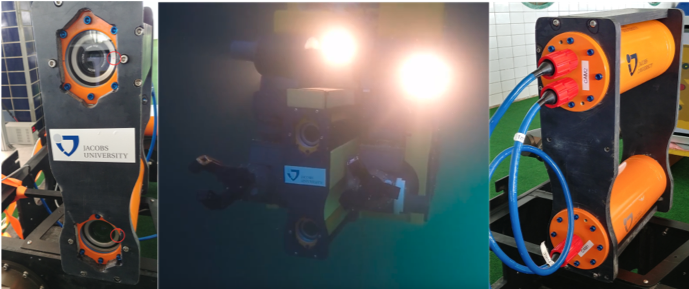Intelligent Deep-Sea Camera System
Commercial ROVs used in deep-sea missions typically rely on analog camera systems. However, the image quality is strongly influenced by the connection to the support vessel, i.e., cable type and length. On-board received images are noisy and streamed disruptively. Based on this, our deep-sea vision system consists of cameras that can be daisy-chained, e.g., for a stereo-setup, and a compute bottle for efficient video streaming or even online vision processing. The cameras provide digital high-resolution images, which are synchronized to enable for example 2.5D environment modeling. The system has been pressure-tested for 2000 meter sea water (msw).
Direct sales, rental agreements, and applications specific software customisation are all possible.
Contact: Dr Andreas Birk, Jacobs University Bremen.
Technical description and applications
The system consists of up to three synchronized but otherwise independent industrial cameras encased in separate pressure housings with flat Sapphire glass windows. This allows for easy adaptation of the final camera configuration. Cameras are connected to a computer housing using standard underwater cables (Subconn Circular Ethernet).
Point Grey Grasshoppers2 cameras were selected which utilize Sony ICX285 CCD sensors, known for good performance in low light conditions. These cameras are equipped with the Fire Wire interfaces to ensure accurate synchronization for stereo reconstruction capabilities; Fire Wire provides hardware-level synchronized capture for all daisy-chained cameras.
Full resolution data from all three cameras can be acquired at 17Hz. It is possible to switch off data acquisition from any of the cameras, allowing a rate of 25Hz for two cameras and 30Hz (maximum rate of the sensor) for one camera. The camera system effectively provides three baselines for the three possible stereo pairs of cameras. The wide pair allows for accurate far range measurements while the shorter baseline pairs allow for close range measurements.
As mentioned, all cameras and their respective deep-sea housing were pressure tested for 2000 msw.
The deep-sea stereo vision system can be mounted in any marine vehicle for applications ranging from archaeology, marine biology to industry. Nonetheless, the housing is best suited for deep-sea intervention tasks such as oil & gas inspections and emerging deep-sea mining activities.
Dependencies to other DexROV components / pre-requisites:
The system handling the captured images by the vision system should have Pointgrey Flycapture software drivers installed.

